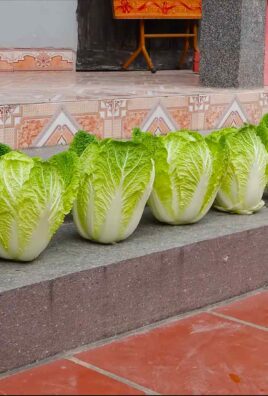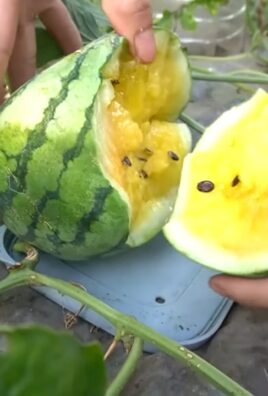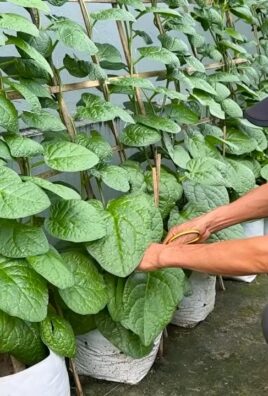Plastic Bottle Pepper Growing: Ever dreamed of harvesting a vibrant bounty of peppers right from your windowsill, even if you’re short on space or a seasoned gardener? I’m here to tell you, it’s totally achievable, and surprisingly simple! Forget expensive gardening equipment and sprawling garden beds. This DIY guide unlocks the secret to cultivating delicious peppers using something you probably already have lying around: plastic bottles!
The beauty of this method lies in its accessibility. While container gardening has been practiced for centuries, think of the Hanging Gardens of Babylon, repurposing materials like plastic bottles adds a modern, eco-conscious twist. It’s a fantastic way to reduce waste while enjoying the fruits (or rather, vegetables!) of your labor.
Why should you embrace plastic bottle pepper growing? Well, for starters, it’s incredibly space-saving, perfect for apartment dwellers or anyone with limited outdoor space. Plus, it offers excellent drainage and aeration for your pepper plants. But more importantly, it’s a fun and rewarding project that connects you with nature and provides fresh, flavorful peppers for your kitchen. Imagine adding a spicy kick to your meals with peppers you grew yourself – the satisfaction is unmatched! So, let’s dive in and transform those empty bottles into miniature pepper paradises!

DIY Self-Watering Pepper Planter from a Plastic Bottle
Hey there, fellow gardening enthusiasts! Are you itching to grow your own peppers but short on space or time? I’ve got the perfect solution for you: a self-watering pepper planter made from a recycled plastic bottle! This project is not only eco-friendly but also incredibly easy and effective. Trust me, even if you’re a complete beginner, you can totally nail this. Let’s get started!
What You’ll Need
Before we dive in, let’s gather all the necessary materials. This will make the whole process smoother and more enjoyable.
* **A Large Plastic Bottle (2-Liter or Bigger):** The sturdier, the better! Look for one that’s relatively smooth and easy to cut. Soda bottles or juice bottles work great.
* **Scissors or a Utility Knife:** Be careful with these! A sharp utility knife will make cleaner cuts, but scissors can work in a pinch.
* **Cotton Rope or Wicking Material:** This is crucial for the self-watering aspect. Cotton rope is ideal because it wicks water effectively. You can also use strips of old t-shirts or felt.
* **Potting Soil:** Choose a good quality potting mix that’s well-draining. Peppers need soil that retains moisture but doesn’t become waterlogged.
* **Pepper Seedlings or Seeds:** You can start with seedlings for faster results or sow seeds directly into the planter. I personally prefer seedlings because I’m impatient!
* **Water:** Obviously!
* **Optional: Pebbles or Gravel:** These will help with drainage in the bottom of the planter.
* **Optional: Spray Paint or Decorative Materials:** If you want to jazz up your planter, feel free to get creative!
Step-by-Step Instructions
Alright, let’s get our hands dirty! Follow these steps carefully, and you’ll have your self-watering pepper planter ready in no time.
1. **Prepare the Bottle:**
* First, give your plastic bottle a good rinse to remove any residue.
* Next, decide where you want to cut the bottle. You’ll be cutting it into two sections: the top section will be inverted and placed inside the bottom section, creating the self-watering reservoir. I usually cut the bottle about one-third of the way down from the top.
* Using your scissors or utility knife, carefully cut the bottle along the line you marked. Be extra cautious with the utility knife!
* You should now have two separate pieces: the top section (the bottle neck) and the bottom section (the bottle base).
2. **Create the Wicking System:**
* This is where the magic happens! Take your cotton rope or wicking material and measure a length that’s long enough to reach from the bottom of the top section (where the soil will be) down into the bottom section (the water reservoir). You’ll want a good portion of the rope to be submerged in the water.
* Thread the rope through the bottle neck. The rope should be hanging down into what will be the water reservoir. Make sure the rope is securely in place so it doesn’t slip out. You might need to tie a knot at the end of the rope inside the top section to prevent it from pulling through.
3. **Assemble the Planter:**
* Invert the top section of the bottle (the one with the rope) and place it inside the bottom section. The bottle neck should be pointing downwards, and the rope should be dangling into the bottom section.
* If you’re using pebbles or gravel, add a layer to the bottom of the top section. This will improve drainage and prevent the soil from becoming waterlogged.
4. **Add the Soil:**
* Now it’s time to fill the top section with potting soil. Gently pack the soil around the rope, making sure it’s evenly distributed. Leave about an inch or two of space at the top of the planter.
* Water the soil thoroughly to help it settle and to ensure the wicking system is working properly. You should see the water being drawn up into the soil.
5. **Plant Your Pepper Seedling or Seeds:**
* If you’re using seedlings, carefully remove them from their containers and plant them in the center of the planter. Make sure the top of the root ball is level with the soil surface.
* If you’re using seeds, follow the instructions on the seed packet for planting depth and spacing. I usually plant a few seeds in each planter and then thin them out later, keeping the strongest seedling.
* Gently water the newly planted seedling or seeds.
6. **Add Water to the Reservoir:**
* Pour water into the bottom section of the bottle, making sure the end of the rope is submerged. Don’t overfill it! Leave some space at the top to prevent spills.
* The rope will act as a wick, drawing water up into the soil as needed. This will keep your pepper plant consistently moist without you having to water it every day.
7. **Find the Perfect Spot:**
* Peppers need plenty of sunlight, so place your self-watering planter in a sunny location. A south-facing window or a sunny balcony is ideal.
* If you’re growing your peppers outdoors, make sure to protect them from strong winds and extreme temperatures.
Maintaining Your Pepper Plant
Now that your self-watering pepper planter is set up, here are a few tips to keep your plant healthy and thriving:
* **Check the Water Level Regularly:** Monitor the water level in the bottom section of the bottle and refill it as needed. The frequency will depend on the weather and the size of your plant.
* **Fertilize Regularly:** Peppers are heavy feeders, so you’ll need to fertilize them regularly to ensure they get the nutrients they need. Use a balanced fertilizer or a fertilizer specifically formulated for peppers and tomatoes. Follow the instructions on the fertilizer label.
* **Prune Your Pepper Plant:** Pruning can help improve air circulation and encourage bushier growth. Remove any yellowing or dead leaves. You can also pinch off the tips of the branches to encourage more branching.
* **Watch Out for Pests and Diseases:** Keep an eye out for common pepper pests like aphids, spider mites, and whiteflies. Treat any infestations promptly with insecticidal soap or neem oil. Also, be aware of potential diseases like blossom end rot and fungal infections.
* **Support Your Plant:** As your pepper plant grows, it may need some support to prevent the branches from breaking under the weight of the peppers. You can use stakes, trellises, or cages to provide support.
Troubleshooting
Even with the best intentions, things can sometimes go wrong. Here are a few common problems you might encounter and how to fix them:
* **Soil is Too Wet:** If the soil is constantly soggy, it could be a sign that the wicking system is too efficient or that the soil is not draining well enough. Try using a less absorbent wicking material or adding more pebbles to the bottom of the planter.
* **Soil is Too Dry:** If the soil is constantly dry, it could be a sign that the wicking system is not working properly or that the water reservoir is empty. Make sure the rope is securely in place and that it’s making good contact with the water. Also, check the water level in the reservoir regularly.
* **Yellowing Leaves:** Yellowing leaves can be a sign of nutrient deficiency, overwatering, or underwatering. Check the soil moisture and adjust your watering accordingly. Also, make sure you’re fertilizing your plant regularly.
* **Blossom End Rot:** Blossom end rot is a common problem in peppers and tomatoes, caused by a calcium deficiency. To prevent blossom end rot, make sure your soil is rich in calcium and that you’re watering your plant consistently. You can also add calcium supplements to the soil.
Adding a Personal Touch
Now for the fun part! Let’s personalize our planters.
* **Paint it!:** Grab some spray paint (outdoor paint is best) and give your bottle a makeover. Solid colors, stripes, polka dots – let your imagination run wild!
* **Decorate with twine:** Wrap twine around the bottle for a rustic, natural look. Secure it with glue.
* **Label it:** Use a permanent marker or label maker to write the type of pepper you’re growing on the bottle. This is especially helpful if you’re growing multiple varieties.
* **Add drainage holes:** If you live in a very rainy area, consider adding a few small drainage holes to the bottom of the planter to prevent waterlogging.
Why This Works
The beauty of this self-watering system lies in its simplicity. The cotton rope acts as a wick, drawing water from the reservoir up into the soil as needed. This ensures that your pepper plant receives a consistent supply of moisture, which is crucial for healthy growth and abundant fruit production. Plus, it reduces the risk of overwatering or underwatering, which are common mistakes that beginner gardeners make.
Final Thoughts
So there you have it! A simple, effective, and eco-friendly way to

Conclusion
So, there you have it! Transforming a simple plastic bottle into a thriving pepper garden is not just a fun project; it’s a sustainable, space-saving, and incredibly rewarding way to enjoy fresh, homegrown peppers. We’ve walked you through the process, highlighting the ease and efficiency of this DIY method. But why is this plastic bottle pepper growing trick a must-try?
Firstly, it’s incredibly accessible. Almost everyone has a spare plastic bottle lying around, turning potential waste into a valuable resource. Secondly, it’s perfect for those with limited space. Whether you have a small balcony, a tiny patio, or just a sunny windowsill, this method allows you to cultivate peppers where traditional gardening might be impossible. Thirdly, it’s a fantastic way to control the growing environment. You can easily move your bottle garden to chase the sun, protect it from harsh weather, or even bring it indoors during colder months.
Beyond the practical benefits, there’s the sheer joy of watching your pepper plants flourish. From the first tiny sprouts to the vibrant, colorful peppers ready for harvest, the entire process is a testament to the power of nature and the satisfaction of DIY.
But don’t stop there! This method is ripe for experimentation. Try different varieties of peppers, from sweet bell peppers to fiery habaneros. Experiment with different soil mixes to find what works best for your climate and pepper type. Consider adding companion plants like basil or marigolds to your bottle garden to deter pests and enhance growth. You can even create a vertical garden by hanging multiple bottle planters, adding a touch of green to any space.
For those looking to maximize their yield, consider using a larger bottle or even connecting multiple bottles together to create a larger growing container. You can also experiment with different watering techniques, such as bottom watering, to ensure your plants receive adequate moisture without overwatering. Remember to regularly fertilize your plants with a balanced fertilizer to provide them with the nutrients they need to thrive.
The possibilities are endless! The key is to embrace the spirit of experimentation and adapt the method to suit your specific needs and preferences.
We wholeheartedly encourage you to give this plastic bottle pepper growing method a try. It’s a simple, sustainable, and incredibly rewarding way to enjoy fresh, homegrown peppers. And once you’ve experienced the joy of harvesting your own peppers from a recycled plastic bottle, we’re confident you’ll be hooked.
Don’t forget to share your experiences with us! We’d love to see your bottle gardens, hear about your successes (and even your challenges), and learn from your unique adaptations. Share your photos and stories on social media using #BottlePepperGarden or leave a comment below. Let’s create a community of bottle gardeners and inspire others to embrace this sustainable and rewarding DIY project. Happy growing!
Frequently Asked Questions (FAQ)
1. What type of plastic bottle is best for growing peppers?
Ideally, you should use a sturdy, food-grade plastic bottle. Two-liter soda bottles or larger water bottles work well. Avoid using bottles that have contained harsh chemicals, as these could contaminate the soil and affect the growth of your peppers. Make sure to thoroughly clean the bottle with soap and water before using it. Clear or translucent bottles are preferable as they allow you to monitor the soil moisture levels. Darker bottles can also be used, but you’ll need to be more diligent about checking the soil.
2. What kind of soil should I use for growing peppers in a plastic bottle?
A well-draining potting mix is essential for growing healthy peppers. Avoid using garden soil, as it can be too heavy and compact, leading to poor drainage and root rot. A good potting mix should contain a blend of peat moss, perlite, and vermiculite. You can also add compost to provide additional nutrients. Consider using a soilless mix specifically designed for container gardening, as these mixes often provide excellent drainage and aeration.
3. How often should I water my pepper plants in a plastic bottle?
The frequency of watering will depend on several factors, including the size of the bottle, the type of soil, the climate, and the stage of growth of the pepper plant. Generally, you should water your pepper plants when the top inch of soil feels dry to the touch. Avoid overwatering, as this can lead to root rot. When watering, water thoroughly until water drains out of the drainage holes at the bottom of the bottle. During hot weather, you may need to water more frequently.
4. How much sunlight do pepper plants need when grown in a plastic bottle?
Pepper plants need at least 6-8 hours of direct sunlight per day to thrive. Place your bottle garden in a sunny location, such as a south-facing window or a sunny balcony. If you don’t have access to enough natural sunlight, you can supplement with artificial grow lights. Rotate the bottle regularly to ensure that all sides of the plant receive adequate sunlight.
5. Do I need to fertilize my pepper plants grown in a plastic bottle?
Yes, pepper plants require regular fertilization to provide them with the nutrients they need to grow and produce peppers. Use a balanced fertilizer specifically formulated for vegetables. Follow the instructions on the fertilizer package for application rates and frequency. You can also use organic fertilizers, such as compost tea or fish emulsion. Fertilize your pepper plants every 2-3 weeks during the growing season.
6. How do I protect my pepper plants from pests and diseases when grown in a plastic bottle?
Regularly inspect your pepper plants for signs of pests or diseases. Common pests that affect pepper plants include aphids, spider mites, and whiteflies. You can control these pests by spraying your plants with insecticidal soap or neem oil. To prevent diseases, ensure good air circulation around your plants and avoid overwatering. If you notice any signs of disease, such as yellowing leaves or spots, remove the affected leaves immediately.
7. Can I grow different varieties of peppers in plastic bottles?
Yes, you can grow different varieties of peppers in plastic bottles. However, it’s important to choose varieties that are well-suited to container gardening. Smaller, compact varieties, such as bell peppers, chili peppers, and jalapenos, tend to perform best in containers. Be sure to provide each plant with enough space to grow and thrive.
8. How long does it take to grow peppers in a plastic bottle?
The time it takes to grow peppers in a plastic bottle will depend on the variety of pepper, the growing conditions, and the climate. Generally, it takes about 60-90 days from transplanting seedlings to harvesting mature peppers. Be patient and provide your plants with the care they need, and you’ll be rewarded with a bountiful harvest.
9. What are some variations I can try with this plastic bottle pepper growing method?
There are many variations you can try to customize this method to your needs. You can create a self-watering system by adding a water reservoir at the bottom of the bottle. You can also experiment with different types of growing media, such as coco coir or perlite. Consider adding companion plants, such as basil or marigolds, to your bottle garden to deter pests and enhance growth. You can even create a vertical garden by hanging multiple bottle planters.
10. What do I do with the plastic bottle after the growing season is over?
After the growing season is over, you can recycle the plastic bottle. Be sure to remove any remaining soil and clean the bottle thoroughly before recycling it. You can also reuse the bottle for other purposes, such as storing garden tools or supplies. Alternatively, you can cut up the bottle and use it as mulch around other plants in your garden.




Leave a Comment